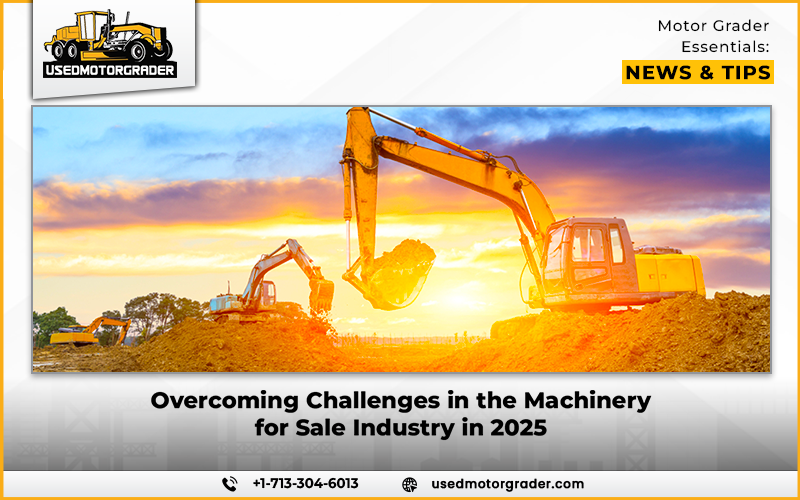The new year begins with new challenges for the heavy construction equipment industry. The problem and challenges have been arising in different stages and phases. From construction sites to the machinery market as a whole. However, like always the companies come up with some innovative ideas to solve these challenges and pass the hurdle. The heavy equipment market is not alone in witnessing this change, but business as a whole is making a shift.
Surprisingly, the shift impacted the companies differently, for some companies it’s profitable and for some it’s an alarming situation. So, what changes have been made so far in the industry? Technological advancement, changing market demands, and fluctuations in the economic sector are the main factors but are not limited to. Amidst these challenges, there are opportunities as well for the growth of machinery for sale in the industry.
The sales and market have been changing from a conventional to a modern paradigm. The current market must guide transformation focusing on customer expectations and increasing demand for sustainable objectives. These challenges are not hurdles if we look at them from other perspectives, but rather an opportunity to reshape the industry for further improvement.
A Market in Flux
It has been more than five years since the outbreak of the pandemic that shook the world. Many businesses and industries have completely revolved from the aftershock but many still are in flux. The supply chain has yet to fully recover since the pandemic outbreak. While overall improvement is evident, sourcing specific equipment may still lead to delays and other issues. The current supply chain disruption is one of the prominent issues that left many equipment traders scrambling to meet demand.
What Problems Industry Are Facing?
Discontinuity between the supply and demand of heavy machinery means that there are gaps between manufacturers, dealers, and customers. It has led to issues such as delays in shipment, which have made the stakeholders give up on proper planning of inventory and shipment. Thankfully, organizations have begun to act more in advance, and are now allocating more resources toward improving communication. Also, increasing the efficiency of supply chains to close these gaps. The goal? Ensure that equipment, whether new or used, is available when and where it’s needed.
Among the others North America has shown the upper hand to tackle the particular issue. Despite the global machinery for sale market slowing down the region made substantial progress in maintaining consistent delivery schedules and offering clearer roadmaps for buyers.
Shifting Customer Expectations
The changing market demand is forced by customer requirements that are changing. Therefore, it is important for companies to meet the changing expectations of the customers. The machinery for sale market is currently not limited to supply and demand but also meeting customer expectations on micro and macro levels of the industry. Today’s customers are not only looking for robust machinery but they search for value and efficiency.
For example, there have been changes in rental agreements and purchase options. Companies have realized that they have to provide versatile payment structures to fit everyone. The sale of a machine is no longer sufficient; you must guarantee the facility’s performance throughout its use. This shift of emphasis implies that firms have to be proactive, knowing not only what their customers want today, but what they will want tomorrow as well.
Embracing Sustainability
Sustainability is no longer a fashion trend; it is an imperative. The construction industry, known for its environmental impact, is facing increasing pressure to “go green.” This change has extended to the machinery for sale market where manufacturers are aiming to produce machines that are energy efficient and environmentally friendly.
Electric and hybrid machinery are gradually taking center stage. These innovations not only help minimize carbon emissions but can also bring long term cost savings as well. Imagine managing a construction project with equipment that uses less fuel and emits fewer pollutants, it is beneficial to the environment and cost effective.
What Is Circular Economy?
It is the concept of reusing and regenerating the product and material. It is making its place in the construction industry, especially for environment-friendly production and usage of heavy equipment and materials. Instead of dumping and discarding the old and used materials and equipment, the companies find a way to utilize them through recycling. The process also helps to reduce waste and other potential benefits, one of which is to make equipment affordable and easily accessible.
Governments and private organizations are also taking the lead, adopting green policies and incentives for sustainable practices. North America, for example, has been a leader in the integration of sustainability goals into large-scale projects, thus setting an example for other regions to follow.
Looking Ahead
The 2025 trends affected the machinery for sale industry, but they are not unavoidable obstacles. However, such challenges are better in the way they offer chances to redesign. The overall approach to business within the industry. The business can respond to challenges facing supply chain operations, how businesses can prepare for and meet changing customer demands, as well as how businesses can embrace corporate social responsibility.
Into this future, the solution goes hand in hand with collaboration. It is now crucial that manufacturers, dealers and customers act collectively. To craft a new market that provides a greater buffer against future shocks, whilst also offering enhanced productivity and sustainability. The future of the machinery for sale industry depends on all stakeholders embracing change and driving growth.


